December 2009 – Volume 13, Number 3
Starfall.com
| Title | Starfall.com (http://www.starfall.com/) |
| Type of product |
Website for preschool, kindergarten, first grade, second grade, special needs, homeschooled, and English language learners (ELD, ELL, ESL) |
| Producers | Stephen Schutz, Susan Polis Schutz, Jared Schutz Polis, Brandi Chase, and a team of educators, artists, designers, animators, musicians, and engineers from all over the world |
| Platform | Web |
| Minimum system requirement |
|
| Price | Free |
Overview
Starfall.com is a free learn-to-read website. It is designed, produced, and published by experts with successful backgrounds and experiences in publishing educational products. Although the website is designed primarily for first grade students, it could be also used with ESL/EFL beginners. Its main purpose is to help learners master speech sounds and letters in a meaningful context where students can “negotiate meaning to accomplish a real-world, communicative task” (Butler-Pascoe & Wiburg, 2003, p. 44).
The website, with its easy navigation tools and visual cues, allows learners to engage in varied activities, games, and materials independently, in pairs, or with the whole class. Moreover, students can choose to save materials on their computers, print them, or email them to share with others inside or outside the classroom. This would allow students to create, for example, individual portfolios. Tasks like these should enhance learners’ confidence, critical thinking, and metacognitive skills (Cummins, Brown, & Sayers, 2007; National Research Council, 2000; Butler-Pascoe & Wiburg, 2003).
Website Contents
The opening page of the website is visually attractive to users (see Figure 1). Under the attractive logo of the website, there is a sentence summarizing the ultimate goal of the website (“Where children have fun learning to read!”). The opening page also has four main colorful and attractive icons representing the stages of reading. Separating the activities into these stages should allow learners to move from one level of comprehension to the next by means of providing them with comprehensible input (Krashen, 1985). The activities at the various stages are designed to enhance not only students’ word and sound building abilities but also to expose students to high-frequency words suitable for their level. These high-frequency lexical items can help students with writing, speaking, and comprehension in relevant contexts (Cummins, Brown, & Sayers, 2007).
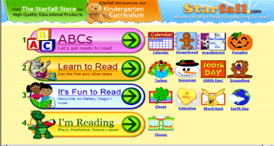 Figure 1. The opening page
Figure 1. The opening page
In addition to the four main icons, there are thirteen other catchy icons on the main page; these include links to additional interactive songs, games, and stories for reading. Some of them are related to different topics in different subject areas. For example, the Calendar icon leads students to interactive and relevant activities not only about how to read and answer questions about dates, but also about how to use dates and numbers (in mathematics) to make a calendar (see Figure 2).
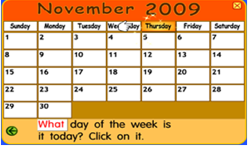 Figure 2. The calendar
Figure 2. The calendar
At the bottom of the main page of the website (see Figure 3), there are another seven links which lead users to:
- the Starfall Store where books and phonics journals that parallel the website are sold
- the Download Center for downloading journals, books, printouts, activities, and the latest version of Adobe Reader
- materials and information for educators
- materials and information for parents
- materials and information about the website’s founder, producers, designers, and so on
- an on-line form for feedback
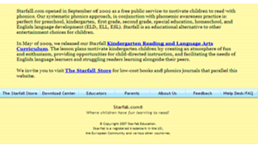 Figure 3. More links on the main page
Figure 3. More links on the main page
Stages of Reading
The first stage of reading on the opening page is “ABC’s: Let’s get ready to read” (see Figure 4). It teaches letter-sound relationships by providing a friendly navigation system that explicitly focuses on each letter of the alphabet. After students learn the predictable relationship between the sounds (phonemes) and letter combinations (graphemes), they are introduced to regular three letter consonant-vowel-consonant (CVC) words.
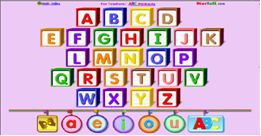 Figure 4. Stage one
Figure 4. Stage one
The activities and games are attractive and interactive. They give time to learners to consciously think about and use the rules available to them in their learned system (Krashen, 1981, 1985). For example, the learners interact with pictures to distinguish the letter T/t from other different letters. A train, for instance, will appear with the lower case and upper case of the letter T and a different letter previously introduced to the students. Then the learners are asked to click on the different letter which is not the letter T/t (see Figure 5). The learners can also listen to funny songs about the letter and its pronunciation as many times as they like. This should help the students not only to learn the target language consciously (learning) but also subconsciously (acquisition) (Krashen, 1981, 1985).
 Figure 5. Interacting with the letter T/t
Figure 5. Interacting with the letter T/t
The second stage is “Learn to Read: Zac the Rat and other tales. ” At this stage, students read and understand beyond sound-letter relationships. When the learners click on the Learn to Read icon, a huge number of stimulating and relevant games, movies, activities, and songs appear on the page (see Figure 6).
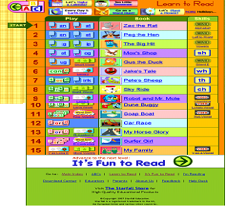 Figure 6. Stage two
Figure 6. Stage two
At this stage, the games, songs, and activities are highly interactive and require students to be effectively engaged for the purpose of reading. They have, for example, the same imperative format as Total Physical Response (Asher, 1965) to stimulate command responses (Right/Left, Back/Side, Over/Under, Spin/Flip) on the screen. For instance, in one game, Dune Buggy, the learners respond to a command by clicking on turn right or turn left (see Figure 7). When the learners click on the turn right sign, an arrow appears indicating the right side and the car and its driver start moving to the right; when the learners click on the turn left sign, an arrow appears indicating the left side and the car and its driver start moving to the left.
 Figure 7. Stimulating command responses
Figure 7. Stimulating command responses
The third stage of reading is “It’s Fun to Read: About Me, Art Gallery, Magic + more!” At this stage, reading is for fun. Reading texts are presented in different interesting contexts and genres such as poetry, music, riddles, and so on (see Figure 8). Pictures, colors, backgrounds, texts, and animations all enhance the highly interactive learning activities (Butler-Pascoe & Wiburg, 2003). The learners can choose where they are, what to do, or what to do in the next stage by clicking or moving the mouse. They can pay attention to both what the movies, songs, videos are saying as well as how they are saying. In other words, the activities and games give time to learners to consciously and subconsciously use the rules available to them in their learned system.
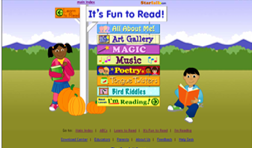 Figure 8. Stage three
Figure 8. Stage three
The last stage of reading is “I’m Reading: Plays, Nonfiction, Comics + more!” At this stage, learners are exposed to different stimulating, interactive and (socially and culturally) relevant genres such as poetry, fiction, folk tales, fables, myths, etc. (see Figure 9). At this stage, the learners can play and interact not only with texts but also with letters, sounds and words, allowing them to review what they have learnt and connect it with what they are currently learning.
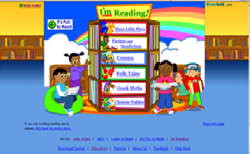 Figure 9. Stage four
Figure 9. Stage four
Evaluation
The website is visually appealing, fun, and stimulating for learners. Its layout is clear and intuitive. Its headings are very clear and visible and the fonts are clear and used consistently. It is easy to navigate through the website because it has easy navigation tools and visuals. The website could also be used with ESL/EFL learners with special needs because of its large print, easy navigation, audio/read-aloud feature, and the slow movement of letters and graphics. In addition, the fact that users can contact the company through the feedback link if they face any problems or technical difficulties adds to the user-friendliness of the website.
The website can aid EFL/ESL teachers “in creating a supportive, nonthreatening learning environment in which second language learners feel secure enough to practice the target language and to make and correct their own errors without embarrassment or anxiety” (Butler-Pascoe & Wiburg, p. 86, 2003). In other words, while using this website students should feel relaxed, comfortable, and excited enough to practice the target language and to reflect on their errors without embarrassment or anxiety which might negatively affect their acquisition (Krashen, 1981, 1985).
The website seems to be able to help move ESL/EFL learners beyond the basics in an incremental fashion. It can help learners construct their knowledge and it builds up to higher levels of thinking in meaningful and relevant contexts. In other words, the website can scaffold ESL/EFL learners’ learning by moving learners from their actual level to the potential level in the Zone of Proximal Development (Vygotsky, 1978).
Furthermore, the website can develop the key characteristics of a communicative language environment, namely “the opportunity for students to use language within a purposeful context” (Butler-Pascoe & Wiburg, 2003, p. 44). For example, asking ESL/EFL students to build sentences comprised of decodable and high-frequency words they are learning in a meaningful and relevant context helps them think critically about how words come together (e.g., Subject-Verb-Object) and how different linguistic structures can be used in different contexts. Also, asking the students to build words using the sound-letter associations they are learning in a meaningful and relevant context helps them analyze and reflect on the nature of the sounds and use the rules with new words in the future.
In addition to making learning interesting, interactive, motivating, and exciting for students, the website encourages ESL/EFL students to express their opinions and trust themselves. Every game or activity helps students to reflect and think critically; for example, after each story or activity, the students are asked, “Did you like this?” They can then click on “Yes,” “No,” or “Kind of” faces to vote on their favorites.
Another positive feature of the website is that the ability to email, print out, or save materials can help the ESL/EFL teacher create student-centered and collaborative learning environments in which students practice and enhance their social, cognitive, and metacognitive skills (Kagan, 1986; National Research Council, 2000). In addition, the teacher can use learners’ work on the website to “demonstrate the student’s motivation, academic growth, and/or level of achievement” (Norton & Wiburg, 2003, p. 234). For example, the teacher can create assessment portfolios for their students which can be “product portfolios,” “process portfolios, ” or “progress portfolios” (Montgomery, 2000). Also, the teacher can help their students to prepare electronic portfolios (e.g., like creating folders for their work) which students can edit, add to, or link new productions to as they complete them (Clarke & Agne, 1997). The students can share and discuss the work in the portfolios with each other, their teachers, or wider audiences such as parents or students from other classes.
Finally, the website is appropriate for learners from a variety of cultures and backgrounds. For example, the website incorporates a section at the third stage of reading called “All About Me!” (see Figure 10). In this section, the students play games to answer four relevant questions: Who Am I?, What Is My Pet?, Where Do I Sleep?, and Which Is My Toy?
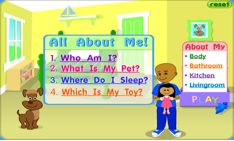 Figure 10. All About Me!
Figure 10. All About Me!
To answer the question of Who Am I?, the students construct characters to look just like themselves. There are different skin colors, a variety of eye shapes and colors, and different hairstyles to choose from (see Figure 11). Also, there are more games about pets, toys, and places of sleep with different characteristics and features to choose from to answer the rest of the questions.
 Figure 11. Who Am I?
Figure 11. Who Am I?
However, learners from some backgrounds might not be familiar with some topics such as Columbus Day, Halloween, Valentine, etc. This might make learners, especially young learners, feel hesitant, frustrated, or uninterested in what they are learning. Teachers will have to explain the new and unfamiliar topics or guide learners to use only what is relevant to them.
On the other hand, many topics and issues, such as Earth Day, are of global interest. In this interactive game, learners work together to clean the planet (see Figure 12).
 Figure 12. Earth Day
Figure 12. Earth Day
Conclusion
In conclusion, Starfall.com is a fun and useful website for learners who are beginning their journey as readers or who need practice with fundamental reading skills. Although it is aimed at younger learners, its attractive presentation and fun and meaningful activities should make it popular and effective for a wide range of learners.
References
Asher, J. (1965). The strategy of total physical response: An application to learning Russian. International Review of Applied Linguistics, 3, 291-300.
Butler-Pascoe, M. E., & Wiburg, K. W. ( 2003). Technology and teaching English language learners. Boston, MA: Allyn and Bacon.
Clarke, J., & Agne, R. (1997). Interdisciplinary high school teaching. Needham, MA: Allyn and Bacon.
Cummins, J., Brown, K., & Sayers, D. (2007). Literacy, technology, and diversity: Teaching for success in changing times. Boston, MA: Allyn and Bacon.
Kagan, S. (1986). Cooperative learning and sociocultural factors in schooling. In California Department of Education (Ed.), Beyond language: Social and cultural factors in schooling language minority students (pp. 231-298). Los Angeles, CA: Evaluation, Dissemination and Assessment Center, California State University, Los Angeles.
Krashen, S. D. (1981). Second language acquisition and second language learning. Oxford: Pergamon Press.
Krashen, S. D. (1985). The input hypothesis: Issues and implications. New York: Longman.
National Research Council. (2000). How people learn: Brain, mind, experience and school. Washington DC: National Academy Press.
Norton, P., & Wiburg, K. (2003). Teaching with technology: Designing opportunities to learn. California: Wadsworth.
Montgomery, K. (2000). Authentic assessment: A guide for elementary teachers. New York: Longman.
Vygotsky, L. S. (1978). Mind in society: The development of higher psychological processes. Cambridge, MA: Harvard University Press.
About the Reviewer
Majid N. Al-Amri is currently an assistant professor in the English Language Department at Yanbu Industrial College, Yanbu, Saudi Arabia. He has a B.A. in English Language and Education from Taibah University (formerly King Abdulaziz University, Saudi Arabia), an M.A. in Applied Linguistics from the University of Essex, UK, and a PhD in Curriculum and Instruction from New Mexico State University, USA. His research interests lie in the area of second language teaching and learning, language education, and educational learning technologies.
<majid_yic yahoo.com>
yahoo.com>
|
© Copyright rests with authors. Please cite TESL-EJ appropriately.
Editor’s Note: The HTML version contains no page numbers. Please use the PDF version of this article for citations. |

